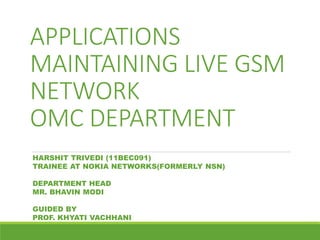11bec091_MajorProject_Presentation_2015
- 1. APPLICATIONS MAINTAINING LIVE GSM NETWORK OMC DEPARTMENT HARSHIT TRIVEDI (11BEC091) TRAINEE AT NOKIA NETWORKS(FORMERLY NSN) DEPARTMENT HEAD MR. BHAVIN MODI GUIDED BY PROF. KHYATI VACHHANI
- 2. ’āśWhere OMC stands in GSM architecture
- 3. OVERVIEW ’āśOMC and its purpose in Telecom ’āśDigital transmission protocols ’āśNetwork management system ’āśApplication applied during the project ’āśConclusion
- 4. OMC IN TELECOM ’āś There are total four departments in NSN RF Planning and Optimization OMC-Transmission BSS Switching ’āś OMC(Operation and Maintenance Centre) is heart of telecommunication. ’āś Very crucial department and working 24x7 round the clock. ’āś In GSM architecture it is situated between BSC(base station controller) to MSC(mobile switching centre)
- 5. DIGITAL TRANSMISSION PROTOCOLS (1) PDH(Plesiochronous digital hierarchy) ’āśPDH is former technology used in telecommunications networks to transport large quantities of data over digital transport equipment via ŌĆ£FIBRE OPTICŌĆØ and ŌĆ£MICROWAVE RADIO SYSTEMSŌĆØ. ’āśPDH allows transmission of data streams that are nominally running at the same rate, but allowing some variation on the speed around a nominal rate. ’āśThere is no link between watches to guarantee they run at exactly the same rate
- 6. (2) SDH(Synchronous Digital Hierarchy) OR SONET(Synchronous Optical Networking) ’āśSDH is successor of PDH, uses TDMA for constant stream of information , it uses optical fibre, microwave radio and electric interface (RJ45 Ethernet radio). ’āśThis method was adopted to send large amounts of telephone calls and data traffic over the same fibre without synchronization problems. ’āśThe STM-1(Synchronous Transport Module level-1) frame is the basic transmission format for SDH.
- 7. Network management system(NMS) ’āśArchitecture of system NMS Switch EMS EMS EMSŌĆ”ŌĆ”ŌĆ”ŌĆ”ŌĆ”ŌĆ”
- 8. ’āśNMS(Network Management System): It provides an integrated system for sharing device information(nodes) across management applications, automation of device management tasks. ’āśThere are three NMSs in NSN. ’āś (1)ECI Telecom: SDH ’āś (2)Huawei: SDH and Ethernet radio ’āś (3)NEC: Ethernet Radio
- 9. ’āśEMS(element management system): It is capable of scaling as the network grows, maintaining high performance levels as the number of network events increase, and providing simplified integration with third-party systems. It meets the service provider's expectations for integrated operational support systems. ’āśEMS function is divided into 5 key areas i.e. fault, configuration, accounting, performance and security ’āśThere are total 8 servers in the system, 7 for EMS allocated according to equipment and 1 for NMS. ’āśCISCOŌĆÖs switches provide soft switching operations.
- 10. MAJOR APPLICATIONS OF NMS ’āśService trail creation ’āśUploading and removal of node ’āśAlarm watching and handling ’āśCreation and restoration of all the configuration detail of network ’āśTraffic shifting ’āśClock synchronization ’āśSwapping of node ’āśUSDM uploading
- 11. Home screen of ECI TelecomŌĆÖs NMS
- 12. ’āś Both the NMS are based on LINUX environment ’āś Attached directly with the system servers via SNMP(Simple Network Management Protocol) ’āś They require third-party client to get logged in within the system and supporting package managers ’āś Huawei uses its own iManager 2000 ’āś ECI uses GOGlobal third party client and SmartLight package manager
- 13. HuaweiŌĆÖs NMS ’āś Cost is less. -Chinese firm ’āś Integrated - Compatible with RTN series(910 and 950) equipment. - Works on both types of channel Optical fiber and Radiolink. ’āś Easy to configure with hardware and servers. - Huawei has own set of hardware. ’āś Service support is very good ’āś Advanced features
- 14. ADVANCED FEATURES ’āś 3 link creation ’āś 4Tunnel service creation ’āś Ethernet over SDH(EOS) path creation
- 15. ’āś Simple node creation and deletion: When new BST unit takes place or to be uploaded virtually on the entire network.
- 17. ’āś 2 node configuration: After node uploading it is required to configure with nearly available existing node
- 18. ’āś We can assign as per the requirement and availability - Frequency(IF), Modulation technique, Bit rate, Tx Power, channel bandwidth, protection path - At last we have to synchronize with real time clock. - Flexible to configure according to type of services. - Here advanced feature of 3-link configuration is available to expand services and bandwidth.
- 19. ’āś 4 tunnel creation: a tunneling protocol allows a network user to access or provide a network service that the underlying network does not support or provide directly. ’āś Here the service provider is a user to take advantage of foreign protocol over existing protocols(SDH, SONET and PDH) for betterment of services offering to subscribers.
- 20. Here we had created 4tunnel service to enable Multiprotocol Label Switching (MPLS) to avoid conventional routing table and provide fast telecommunication network.
- 21. Enable PWE service using 4tunnelin: pseudo-wire (PWE) is an emulation of a point-to-point connection over a packet-switching network (PSN). Here we enabled 3g via circuit emulation service(CES).
- 22. ETHERNET IN TELECOM ’āś Carrier Ethernet (ETH) is useful in telecommunications network providers to provide Ethernet services to customers and to utilize Ethernet technology in their networks. Important terms: - CIR: Committed information rate, the average bandwidth for a virtual circuit - PIR: Peak Information rate - EIR: Excessive information rate - PIR= CIR + EIR These data is required to enable and control Data pack over ETH
- 23. tightVNC FOR CONFIGURATION ’āś TightVNC is a cross-platform free and open-source remote desktop software application that uses and extends the RFB protocol of Virtual Network Computing (VNC) to control another computer's screen remotely ’āś RFB( Remote Frame Buffer) is the protocol to use and control remote computer using GUI. ’āś It is most preferable VNC platform for Windows operated computer to work on server level administration.
- 24. CONCLUSION ’āś learnt different parameters, protocols, tools, architecture being used in recent telecom industry from the scratch. I started with fundamentals of telecom protocols and architecture subsequently became familiar with major tools. ’āś Designed various services operating live GSM network as well as bootstrapped the problems maintaining those services properly using different applications.

























